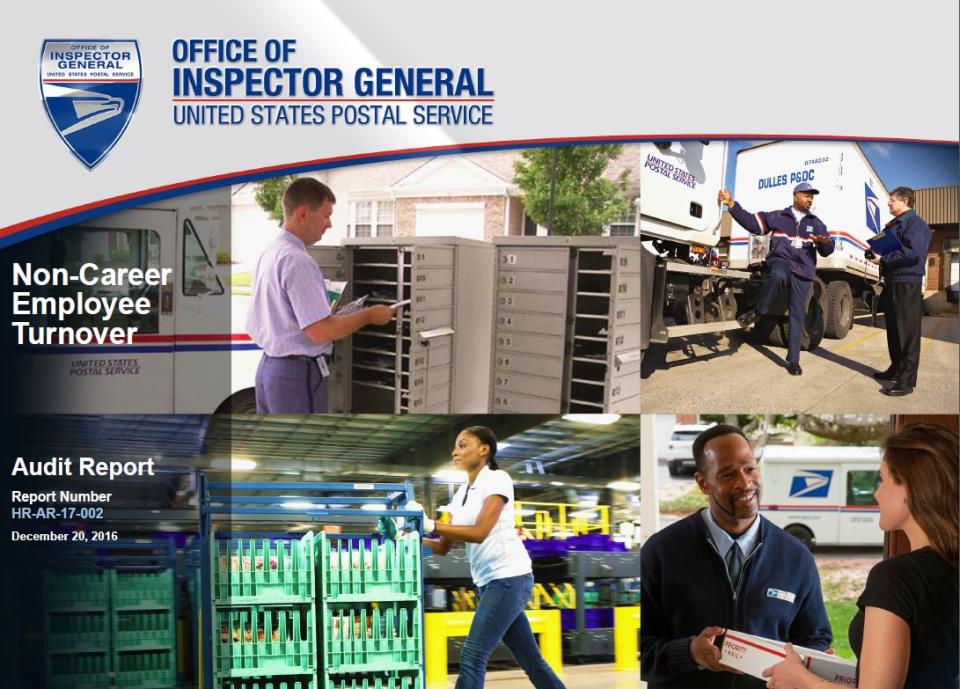Non-Career Employee Turnover
Background
The U.S. Postal Service hires non-career employees to supplement its regular workforce and reduce staffing costs. Non-career employees are temporary workers who do not receive full employee benefits and privileges. In fiscal year (FY) 2016, the Postal Service employed an average of about 130,000 non-career employees.
The Postal Service has four crafts that constitute the non-career employee portfolio: (1) the mail handler assistant position that unloads and moves mail in plants, (2) the postal support employee position that processes mail and sells postage at post offices, (3) the city carrier assistant (CCA) position that delivers mail on designated city routes and (4) rural carrier associate position that delivers mail on designated rural routes.
In October 2014, the Postal Service created a CCA recruitment and retention strategy to provide field Human Resources staff, managers, and supervisors with resources and strategies for the recruitment and retention of CCAs.
In FY 2015, the Postal Service formed a joint Human Resources and operations team to evaluate turnover. Subsequently, the Postal Service created initiatives for FY 2016 to reduce turnover and improve training.
In FY 2015, non-career employee turnover cost the Postal Service about $95.1 million to hire and onboard replacements.
Our objective in this project was to assess non-career employee turnover and identify opportunities to optimize non-career staffing. Because the Postal Service needs a flexible workforce and is facing a tightening labor market, we may conduct further work on the strategic use of this key resource in the future.
What the OIG Found
Opportunities exist to reduce non-career employee turnover by addressing factors such as scheduling flexibility, physical demands of the job, and supervisory relationships that contributed to non-career employee turnover.
In FY 2016, the combined annual turnover rate for all four non-career crafts was 42.7 percent (monthly average of 3.6 percent), which did not meet the National Performance Assessment goal of 34.8 percent annually (2.9 percent per month). Leveraging best practices in establishing and implementing mentoring and training activities for all crafts could help reduce these high turnover rates.
Lastly, unit managers did not always review workhour reports and submit non-career separation forms timely. Consequently, 1,223 of 2,208 (55.4 percent) non-career separation forms were submitted from 1 to 38 days after employees separated and not the day of separation as required.
These conditions occurred because the Postal Service does not have a recruitment and retention strategy to help reduce attrition rates to sustainable levels and ensure all non-career crafts are appropriately mentored and trained. In addition, they did not ensure that areas and districts implemented mentoring and training activities outlined in the CCA strategic plan. Lastly, unit managers were not required to evaluate workhour reports to identify and timely remove separated employees.
If the turnover rate goal had been met, the Postal Service hiring and onboarding costs for FY 2016 would have been reduced by over $23 million. Furthermore, as the Postal Service converts many non-career employees to career employees, investments in mentoring and training would better prepare the employees for both current and future roles. Lastly, when a district or site reaches its maximum complement and does not remove separated employees from payroll, the system does not update to reflect a vacancy and replacements cannot be hired.
The Postal Service took corrective action by implementing a field onboarding program nationwide beginning October 1, 2016. This program will include pre-hire communication, employee orientation, on-the-job training for all crafts, and updated rural and city carrier academies. Therefore, we are not making any recommendations regarding training.
What the OIG Recommended
We recommended management establish a comprehensive non-career employee strategic plan for all crafts that addresses contributing factors identified by Postal Service data and an oversight process to ensure areas and districts implement retention activities. We also recommended management institute formal requirements for unit managers to evaluate workhour reports to identify and timely remove separated employees.

